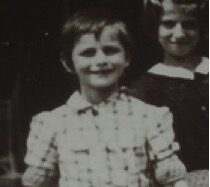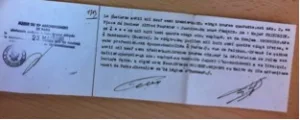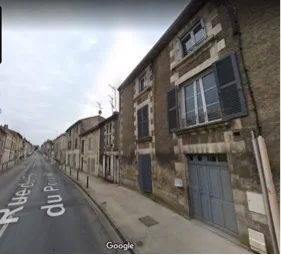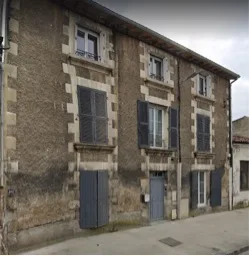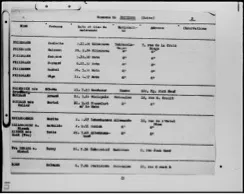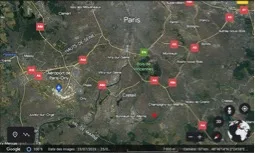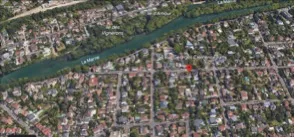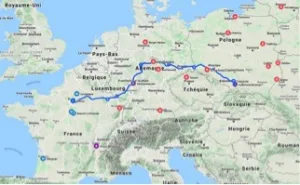Justine FRIEDRICH
Justine Friedrich was born on April 14, 1938, in Paris, France. Her parents were Chewa Grunberg and Majer or Major Friedrich.
Before the Second World War, she lived at 7 rue de Palikao, in the 20th district of Paris, most likely with her mother. There is little mention of her father, either in Paris or in Poitiers, the city to which the family probably fled at the start of the Nazi occupation.
Cheva Bina Friedrich, Justine’s mother, was born on July 25, 1893 in Sandomierz, which was then in Russia but became part of Poland after the First World War. Her maiden name was Grunberg.
According to the OFPRA (Office Français de Protection des Réfugiés et Apatrides or French Office for the Protection of Refugees and Stateless Persons) archives, she left her hometown in Russia (now Lodz, in Poland) in 1919 and moved to Germany.
She lived in Germany until 1925, when she left for Belgium. We next found a trace of her in France, where she arrived in 1934 on a Nansen passport (a stateless person’s passport). A note was made at the time saying “she has no identity card, her stay is limited. There is no indication that she has obtained a foreign nationality”.
The Russian Refugee Office certified that Mrs. Cheva Binah Grunberg, married name Friedrich, was the daughter of Jacob Grunberg and his wife Laja Reichmann.
Justine’s father, Major Friedrich, was born in 1886. Justine’s birth certificate does not mention her place of birth, but we do know that in 1938, she had a salaried job.
In the “Testimonies of Jewish Holocaust Survivors at the USC Shoah Foundation – Interviews and Oral Histories” archives, Cheva Grunberg and Major Friedrich, her husband, are listed. The dates of death match those listed in the Schewa Holocaust Survivors and Victims Database
It also notes that they had three children:
- A son, Jacob Friedrich, born in Dortmund in Germany. He married twice, firstly to Cypa Friedrich and then to Marie Friedrich. He recounts his life in a book entitled “By the Hand of Hachem – To Survive and Thrive: The Miraculous life of Rabbi Yaakov Friedrich” The introduction reads: Abandoned by his father at the of six and age left to be raised by a callous, drunken Catholic peasant, Yaakov Friedrich had no realistic chance of ever learning Torah and keeping mitzvot. But through incredible hashgachah pratis, he is eventually adopted by the Belgian Jewish community and raised in a deeply religious Torah environment.
- Two daughters: Chaja Friedrich and Margreet Friedrich.
This suggests that Justine had some older siblings, which is confirmed by The Central Database of Shoah Victims’ Names testimonial page (form issued by Yad Vashem), where her grandson Jacques Foresti, who was living at 12 rue de Bellevue in Boulogne, France, attests to his grandmother’s arrest in 1942.
Justine’s mother was arrested in Poitiers, where she was living at the time, on October 16, 1942. She had two known addresses in Poitiers: the first was 8 rue de la Pierre Levée, the second 100 Faubourg du Pont-Neuf. But what happened to her daughter after she was arrested? The Yad Vashem testimonial sheet suggests that she was spared. In the book about Elie Bloch, “Le rabbin des enfants” (The Children’s Rabbi), Justine is mentioned in connection with the fact that she was placed in foster care with a Mrs. Cacault, who reported that “she is back in hospital and the doctor says she is contagious”. It goes on to say that “Mrs. Cacault regularly takes young Justine for treatment at the Hôtel-Dieu” (a hospital in Poitiers). We can assume therefore that Justine was not taken to the internment camp on the route de Limoges in Poitiers, which her mother was, according to the camp residents’ list held in the Vienne departmental archives.
100 rue du Faubourg du Pont Neuf in Poitiers – Google Maps
Cheva Bina Friedrich was deported from Drancy to Auschwitz-Birkenau on Convoy 42 on November 6, 1942. She did not survive.
Life in Poitiers can hardly have been easy for the Friedrich family, for although at the start of the war Poitiers welcomed refugees from the Lorraine region, on May 23, 1940, as the Belgian government fled the German advance, the city was occupied by the Nazis, who requisitioned the most important buildings and took over the whole city.
The camp on the Limoges road in Poitiers, which was known as the “Centre de séjour surveillé” (Supervised residential center), had been built in 1939 to house Spanish refugees. However, when the Germans arrived, they cleared the camp and used it to intern gypsies and subsequently The barracks used to house the Jews were dilapidated and poorly maintained: the roofs were damaged and let in the rain, and there were no chairs, benches or tables. Mice and rats devoured everything, and it was not unusual for people to find their clothes, often the only garments they owned, gnawed and riddled with holes in the morning.
July 1942 saw the start of the deportation. Gypsy men were deported via Compiègne, while the Jews were deported via Drancy. In all, some 1,800 Jews were detained in the Poitiers camp before being deported to the concentration camps and killing centers.
The Yad Vashem testimonial sheet, signed by Paul Curtz, a Jewish child survivor of the round-up at the Zysman boarding house, describes how Justine passed through the Lamarck children’s center in Paris on June 19, 1943, then Montgeron (?) and then Louveciennes. Eventually, she was taken in by the Zysman couple in their house at 57 rue Georges Clemenceau in Saint-Maur-des-Fossés, near Paris.
The Zysman boarding house, known as “The Children’s Home”, was at 57 rue Georges Clémenceau in La Varenne-Saint-Hilaire, in the Val-de-Marne department of France. It was a safe house for children whose parents had been persecuted, deported or murdered. It was managed by the UGIF (Union générale des Israélites de France, or General Union of French Jews), an organization founded in 1941. The UGIF was set up to represent Jews in their dealings with the public authorities on issues involving assistance, welfare and changes in social status. All Jews living in France were expected to join, all other Jewish organizations having been dissolved and their assets transferred to the UGIF. Its role was controversial: the facilities it supervised turned out to be traps when the Gestapo carried out roundups.)
The home was full and overcrowded. It was on the banks of the Marne river and easily reached by train from Paris.
Saint-Maur-des-Fossés, south of Paris
The Zysman boarding house was at 57 rue Georges. Clemenceau
Around thirty children stayed there on a permanent basis. The food was reasonable, the atmosphere cheerful, and celebrations such as Hanukkah were held; but as was the case for most UGIF centers, food and clothing were in short supply. The staff took care of the children as best they could with the limited resources available.
Justine was one of those children. She was arrested at the boarding house on the night of July 21-22, 1944.
In July 1944, the Gestapo began targeting the UGIF children’s homes. The children staying in them were the most vulnerable of all French Jews, since many of their parents had already been deported.
In the home in La Varenne, there were 28 children aged from 4 to 11, together with two staff members, the cook and the manager.
They were woken up at dawn, made to get out of bed and wait in Gestapo cars. They were then taken to Drancy camp. During the ten days that Justine spent in Drancy camp, the living conditions were appalling. She had to sleep on straw in a large room. The sanitary facilities were terrible and it was a very unhealthy environment.
The children, along with the people taking care of them, were taken from Drancy to the Paris-Bobigny station and from there deported to Auschwitz on July 31, 1944 on Convoy 77.
Some 1,320 people, from 37 different countries, were deported on this transport, including 330 children under the age of 18.
The train was made up of 30 cattle cars. Some of them had a bucket of water and an extra box of supplies. The floor was partly covered with straw. The train passed through numerous bombed-out stations along the way. The convoy followed the usual deportation route.
Of the 28 children who were rounded up in La Varenne St-Hilaire, none survived.
Justine, who was just six years old, was murdered in the gas chambers at Auschwitz-Birkenau as soon as she arrived there, on August 3, 1944.
Authors
The students of the 9th grade class 3e at the Jardin des Plantes middle school in Poitiers, in the Vienne department of France.
Ms. Myriam Rossignol, librarian/documentalist and teacher
Ms. Isabelle Brandela, history, geography and ethics and civic education teacher
With thanks to Ms. Carla Spodeck, a student at the Political Studies Institute in Poitiers
Bibliography
- Picard Roger : La Vienne dans la guerre 1939-1945. La vie quotidienne sous l’Occupation – De Borée éditions, 2001
- GéoHistoire – La France sous l’Occupation – Hors série, septembre/octobre 2011
- Simmat Gérard, Augustin Jean-Marie : Poitiers occupé, Poitiers bombardé – Geste éditions, 2013
Links
- Justine
Ressources Mémorial de la Shoah
Enregistrements de mémorial de tombe – Find a Grave - Famille
ancestry.fr - Liens convoi 77
legifrance.gouv.fr - Mémorial de la déportation des juifs d’Europe
stevemorse.org - yad vashem
- pension zysman
itinerairesdememoire.com
view.genial.ly
motsaiques2.blogspot.com
hillelweb.com


 Français
Français Polski
Polski